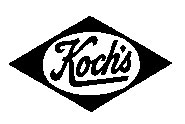Fred Koch Brewery
 Fred Koch Brewery
Fred Koch BreweryThe original Fred Koch Brewery was a small, independent brewery in Dunkirk, New York that produced beer and ale from late 1888 until 1985. Production peaked in the early 1950s with over 100,000 barrels brewed annually. When the Dunkirk, New York brewery was closed in 1985, it was located at 15-25 West Courtney Street.
The Genesee Brewing Company currently owns the trademark rights to the name Fred Koch Brewery but it is not producing any products under the Koch's name.
The brewery was not connected to Jim Koch of Samuel Adams (beer) fame.
Organized in the spring of 1888 by Fred Koch and Frank Werle as the Lake City Brewery, the company began its operation in the Fink brewery in the town of Dunkirk, New York. The first few months of operation were handled by just three men. Mr. Koch made sales and deliveries and Mr. Werle and one assistant ran the brewery. In the fall of 1888, the company built a new brewery on the old Newman tannery property on the corner of Ruggles and West Courtney streets in the city of Dunkirk, New York.
On May 8, 1896, a disastrous fire completely destroyed all but the brewery cellars. During the rebuilding process, Fred Koch purchased from Mr. Werle his interest in the business. The brewery was then owned and operated solely by the Koch family. The business was incorporated in April 1911 prior to the death of Fred Koch, who died while on a visit to Germany. After his death, his three sons, William L., Fred C., and Henry J. Koch, assumed management.
On September 24, 1915, Fire Chief John F. Meiers broke his leg, several firemen were injured, and eight horses were burned to death in a fire at the Fred Koch brewing plant. The fire broke out in the horse barns on the southwest end of the plant in East Courtney Street and spread rapidity. A few weeks early, an incendiary fire broke out in the same part of the plant.
Products sold included "Bock Beer", "Wurtzburger" (an old-fashioned German brew), and "Lake City Export". The brewery continued to produce beer and ale until prohibition in 1920.
Prohibition became effective January 16, 1920, and continued in the United States until December 5, 1933. During these years, the Fred Koch Beverage Company's principal business was soft drinks and made such licensed products as Ward's "Orange-Crush" (an orange drink), Welch's "Welch-ade" (a grape drink) and "Green River" (a lime drink). It also produced a small amount of "near-beer" called "Kobru", a beverage containing less than one-half of 1% of alcohol. "Kobru" was legal under the law, but was not favorably received by residents of Dunkirk, New York.
...
Wikipedia